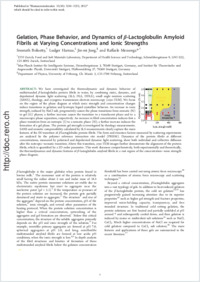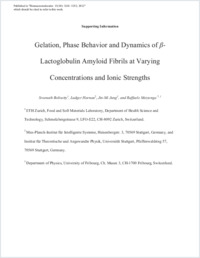Gelation, phase behavior, and dynamics of β-Lactoglobulin amyloid fibrils at varying concentrations and ionic strengths
- Bolisetty, Sreenath ETH Zurich, Food and Soft Materials Laboratory, Department of Health Science and Technology, Switzerland
- Harnau, Ludger Max-Planck-Institut für Intelligente Systeme, Stuttgart, Germany - Institut für Theoretische und Angewandte Physik, Universität Stuttgart, Germany
- Jung, Jin-Mi Department of Physics, University of Fribourg, Switzerland
- Mezzenga, Raffaele ETH Zurich, Food and Soft Materials Laboratory, Department of Health Science and Technology, Switzerland
-
27.08.2012
Published in:
- Biomacromolecules. - 2012, vol. 13, no. 10, p. 3241–3252
English
We have investigated the thermodynamic and dynamic behavior of multistranded β-lactoglobulin protein fibrils in water, by combining static, dynamic, and depolarized dynamic light scattering (SLS, DLS, DDLS), small angle neutron scattering (SANS), rheology, and cryogenic transmission electron microscopy (cryo-TEM). We focus on the region of the phase diagram at which ionic strength and concentration changes induce transitions in gelation and lyotropic liquid crystalline behavior. An increase in ionic strength, induced by NaCl salt, progressively causes the phase transitions from nematic (N) to gel (G) phases; a further increase causes the transition to a translucent phase and to a macroscopic phase separation, respectively. An increase in fibril concentration induces first a phase transition from an isotropic (I) to a nematic phase (N); a further increase induces the formation of a gel phase. The protein gel strength is investigated by rheology measurements. SANS and osmotic compressibility calculated by SLS measurements clearly capture the main features of the IN transition of β-lactoglobulin protein fibrils. The form and structure factors measured by scattering experiments are analyzed by the polymer reference interaction site model (PRISM). Dynamics of the protein fibrils at different concentrations, measured by polarized and depolarized dynamic light scattering, show both individual and collective diffusion after the isotropic–nematic transition. Above this transition, cryo-TEM images further demonstrate the alignment of the protein fibrils, which is quantified by a 2D order parameter. This work discusses comprehensively, both experimentally and theoretically, the thermodynamics and dynamic features of β-lactoglobulin amyloid fibrils in a vast region of the concentration–ionic strength phase diagram.
- Faculty
- Faculté des sciences et de médecine
- Department
- Département de Physique
- Language
-
- English
- Classification
- Physics
- License
- License undefined
- Identifiers
-
- RERO DOC 30532
- DOI 10.1021/bm301005w
- Persistent URL
- https://folia.unifr.ch/unifr/documents/302648
Other files
Statistics
Document views: 84
File downloads:
- jun_gpb.pdf: 225
- jun_gpb_sm.pdf: 157

